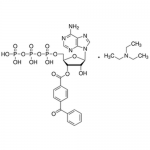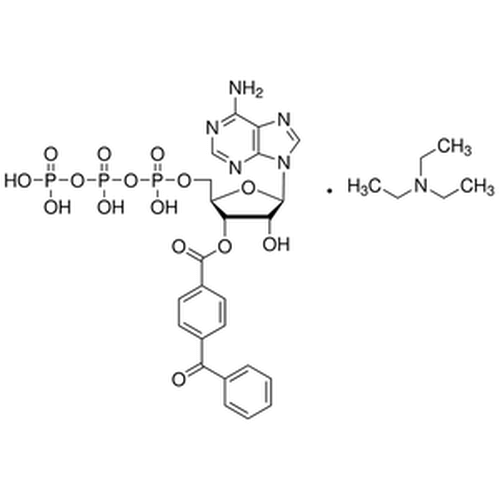| Product Name | BzATP |
| Description |
Prototypic P2X7 receptor agonist |
| Purity | 97.7% |
| CAS No. | 112898-15-4 |
| Molecular Formula | C24H24N5O15P3•C18H45N3 |
| Molecular Weight | 1018.97 |
| Field of Use | Not for use in humans. Not for use in diagnostics or therapeutics. For in vitro research use only. |
Properties
| Storage Temperature | -20ºC |
| Shipping Temperature | Shipped Ambient |
| Product Type | Agonist |
| Solubility | Soluble in water. |
| Source | Synthetic |
| Appearance | Off white solid |
| SMILES | [C@H]3(O[C@@H]([C@@H](OC(=O)C1=CC=C(C=C1)C(=O)C2=CC=CC=C2)[C@H]3O)CO[P](O[P](O[P](=O)(O)O)(=O)O)(=O)O)[N]4C5=C(N=C4)C(=NC=N5)N |
| InChI | InChI=1S/C24H24N5O15P3.C6H15N/c25-21-17-22(27-11-26-21)29(12-28-17)23-19(31)20(16(41-23)10-40-46(36,37)44-47(38,39)43-45(33,34)35)42-24(32)15-8-6-14(7-9-15)18(30)13-4-2-1-3-5-13;1-4-7(5-2)6-3/h1-9,11 |
| InChIKey | HVOVBTNCGADRTH-WBLDMZOZSA-N |
| Safety Phrases |
Classification: Not WHMIS controlled. Safety Phrases: S22 - Do not breathe dust. S24/25 - Avoid contact with skin and eyes. S36/37/39 - Wear suitable protective clothing, gloves and eye/face protection. |
| Cite This Product | BzATP (StressMarq Biosciences Inc., Victoria BC CANADA, Catalog # SIH-420) |
Biological Description
| Alternative Names | 2'(3')-O-(4-Benzoylbenzoyl)adenosine-5'-triphosphate tri(triethylammonium) salt |
| Research Areas | Ion Channels, Neuroscience |
| PubChem ID | 71308559 |
| Scientific Background | BzATP (2′,3′-O-(4-benzoylbenzoyl)-ATP) is a potent agonist of the P2X7 receptor, exhibiting significantly greater efficacy than ATP. P2X7 receptors are ATP-gated ion channels expressed predominantly in microglia and are key mediators of neuroinflammatory responses. Activation of P2X7 by BzATP induces calcium influx, cytokine release, and inflammasome activation—processes implicated in the pathogenesis of neurodegenerative diseases such as Alzheimer’s, multiple sclerosis, and amyotrophic lateral sclerosis. BzATP is also used to study purinergic signaling and glial cell activation in models of brain injury and chronic inflammation. Its high potency and receptor specificity make it a valuable tool for dissecting neuroimmune mechanisms in the CNS. |
| References | 1. Young M., Pelegrin P., & Surprenant A. (2007) Mol Pharmacol. 92-100. |



Reviews
There are no reviews yet.